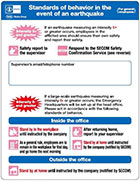Activities related to the Great East Japan Earthquake
Formulation and revision of the Chugai Earthquake BCP
Chugai formulated the Chugai Earthquake Business Continuity Plan (BCP) in 2010 to avoid disruption of critical operations in the event of a disaster, and to restore operations within an acceptable timeframe if they are interrupted.
The basic policy of the Chugai Earthquake BCP is to place top priority on the safety and security of employees, and then to ensure the stable supply of products and protect research resources and other key assets. The Chugai Earthquake BCP includes provisions for organizational frameworks, action guidelines, a response manual, preparedness measures and other procedures in the event of a major earthquake. We continuously strive to improve the effectiveness of these measures through training, verification and updating as needed.
Organizational Framework in the Event of a Major Earthquake
Under the Chugai Earthquake BCP, the following organizational hierarchy is to be set up to respond if a large-scale earthquake with an intensity of 6- or higher occurs in the vicinity of a Chugai business site.

Ensuring Awareness within the Company
A handbook for responding to large-scale earthquakes and a wallet-sized card with action guidelines are distributed to all employees to inform them about the Company-wide emergency response system and what to do in the event of an earthquake. To ensure early first response to an earthquake, safety confirmation drills are conducted for all employees.

Earthquake Action
Guideline Card
Measures to Ensure Stable Product Supply
Reliably delivering products to patients is one of Chugai’s most important missions. We therefore focus in particular on measures to ensure stable product supply. Under the Chugai Earthquake BCP, response teams are established for different functions, such as supply chain management (SCM), manufacturing and safety, following a major earthquake. Tasks include restoring manufacturing equipment and clean environments at plants, adjusting inventory and shipping at distribution centers, and ensuring business continuity at alternate sites, all in an effort to quickly restore operations and maintain critical functions.
Based on our experience in the Great East Japan Earthquake, we have re-analyzed risks to supply by product, and are promoting measures to ensure stable product supply that combine risk mitigation measures such as (1) inventory buildup, (2) production at multiple sites and (3) storage of inventory at dispersed locations.
Seismic Diagnosis and Retrofitting of Production Facilities
Chugai launched a facility seismic retrofitting project in 2011 to strengthen buildings and facilities. We conducted comprehensive seismic diagnosis and risk assessments of plants, research laboratories and distribution centers, and identified approximately 3,000 rooms requiring retrofitting from the standpoint of risk to human life or business. Retrofitting work was conducted between September 2012 and March 2014, along with measures taken at a total of 69 facilities and offices to prevent furniture and fixtures from falling over.
